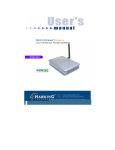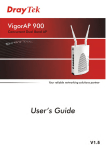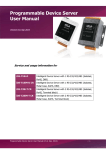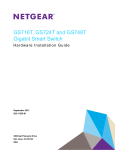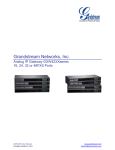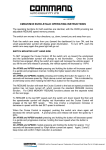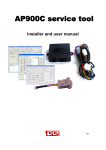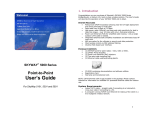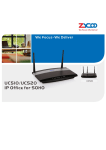Download W ireless 802.11g Access Point
Transcript
User’s Manual Wireless 802.11g Access Point Security ............................................................................................................ 19 PSK pass-phrase............................................................................................ 20 Advanced (Advanced Wireless) ..................................................................... 17 Maximum associated stations ....................................................................... 17 Repeater (WDS) .............................................................................................. 16 Access (Access Control) .................................................................................. 15 Wireless (Wireless Configuration)................................................................. 13 Visibility Status ............................................................................................. 13 Assoc(Associations) ......................................................................................... 12 Info(Information) ............................................................................................ 11 Login................................................................................................................. 10 WPA AP -CONFIGURATION VIA WEB ............................................... 10 GETTING CONNECTED........................................................................ 9 Ports on the Rear Panel .................................................................................... 8 LED Indicators.................................................................................................. 6 Solid ................................................................................................................ 6 About the Operation Modes............................................................................. 2 INTRODUCTION.................................................................................... 1 Table of contents Find................................................................................................................... 37 Reset ................................................................................................................. 36 RESET TO THE FACTORY DEFAULTS .............................................. 36 Admin (Administration)................................................................................. 33 Device Name................................................................................................. 33 Commands: Reboot/Reset this device........................................................... 34 Upgrade system firmware ............................................................................. 34 Advanced (Advanced Wireless) ..................................................................... 31 Maximum associated stations ....................................................................... 31 Wireless (Wireless Configuration)................................................................. 29 Wireless Mode .............................................................................................. 29 Info(Information) ............................................................................................ 28 Login................................................................................................................. 27 BRIDGE -CONFIGURATION VIA WEB ............................................... 27 Admin (Administration)................................................................................. 25 Change password. ......................................................................................... 25 Reboot/Reset this device............................................................................... 25 Upgrade system firmware ............................................................................. 25 IP Addr (IP Address Settings) ........................................................................ 24 IP Address Mode ........................................................................................... 24 Access point name ........................................................................................ 24 Enable WEP .................................................................................................. 23 If this equipment does cause harmful interference to radio However, there is no guarantee that interference This equipment should be installed and operated with a minimum distance of 20cm between the radiator and your body. environment. This equipment complies with FCC RF radiation exposure limits set forth for an uncontrolled FCC RF Radiation Exposure Statement user's authority to operate the equipment. Any changes or modifications not expressly approved by the grantee of this device could void the CAUTION -- Consult the dealer or an experienced radio/TV technician for help. connected. -- Connect the equipment into an outlet on a circuit different from that to which the receiver is -- Increase the separation between the equipment and receiver. -- Reorient or relocate the receiving antenna. encouraged to try to correct the interference by one or more of the following measures: or television reception, which can be determined by turning the equipment off and on, the user is will not occur in a particular installation. cause harmful interference to radio communications. radiate radio frequency energy and, if not installed and used in accordance with the instructions, may This equipment generates, uses and can These limits are designed to provide reasonable protection against harmful interference in a residential installation. pursuant to Part 15 of the FCC Rules. This equipment has been tested and found to comply with the limits for a Class B digital device, FEDERAL COMMUNICATIONS COMMISSION INTERFERENCE STATEMENT -1- Placed anywhere along with an Ethernet LAN, the Wireless 802.11g Access Point allows up to 200 wireless stations within its area of coverage to access transparently to the corporate network. The web-based configuration utility allows users to configure via web browser. Advanced setup and firmware upgrade can be done easily. Points. While acting as a Bridge, this device connects wireless stations for inter-LAN connection. This device can support three modes, i.e. Access Point, Repeater and Bridge. With the Repeater (WDS) functionality, the distance of wireless connection can be extended and wireless clients can roam between Access The Wireless 802.11g Access Point provides 64/128 bit WEP encryption and IEEE802.1x which ensures a high level of security to protects users’ data and privacy. The MAC Address filter prevents the unauthorized MAC Addresses from accessing your Wireless LAN. Your network security is therefore double assured. The Wireless 802.11g Access Point is an IEEE802.11g compliant access point, it not only provides a high transfer rate up to 54Mbps, which is almost five times faster than the already existing 11Mbps 802.11b products, but is also backward compatible with the Wireless B equipments. Introduction Access Point: When acting as an access point, this device connects all the wireless points (PCs) to a wired network. See the sample application below. -2- perform the Firmware Upgrade to upload the firmware from the included CD for Access Point mode. Refer to the section titled “Upgrade system firmware” for details. If you are currently in Bridge mode and want to change to Access Point, 1. This device provides multiple operational applications with Access Point, Repeater (WDS) and Bridge (Infrastructure and Ad-hoc) modes, which are mutually exclusive. About the Operation Modes Repeater (WDS): When in the Repeater (WDS) mode, AP1 (with Station 1 being associated to) and AP2 (with Station 2 being associated) can communicate with each other. Both Station 1 and Station 2 are able to access the Internet if only AP1 or AP2 has the Internet connection. -3- mode. Refer to the section titled Repeater (WDS) for more details to set up WDS. You can only enable WDS functionality when you are in the Access Point 2. Bridge (Infrastructure): When acting as a Bridge, this device serves as a wireless client that connects wired stations (refer to the following illustration) to other access point(s). When becomes a wireless station (AP1 plus the connected computer 1, 2 and 3) can have the Internet access if the other Access Point (AP2) has the Internet connection. -4- perform the Firmware Upgrade to upload the firmware from the included CD for Access Point mode. Refer to the section titled “Upgrade system firmware” for details. If you are currently in Access Point mode and want to change to Bridge, 3. Bridge (Ad-hoc): When set to the Bridge (Ad-hoc) mode, this device can only work when connected to a computer, and will work like a wireless station. You can share files and printers between wireless stations (PC and laptop with wireless network adapter installed). The Bridge (Ad-hoc) mode is only for inter-LAN connection and will not communicate with any wired network. -5- This device is shipped with configuration that is functional right out of the box. If you want to change the settings in order to perform more advanced configuration or even change the mode of operation, you can use the web-based utility provided by the manufacturer as described in the following sections. 4. Dim when no Ethernet is connected. Flashing when this device is sending/receiving data Dim for 10 Mbps Ethernet Glows when Ethernet is connected. Glows for 100Mbps LAN-Link LAN-100M -6- Flashing when upgrading firmware. Normal Status Dim/ Flashing Glows when power is Dim when no power is applied to this device, the applied. LED turns solid yellow. Solid Status Power LED Indicator LED Indicators on the Front Panel LED Indicators Dim when no WLAN is connected. Flashing when trying to connect to WLAN. Flashing when this device is actively sending/receiving data over the wireless LAN connection. Glows when WLAN is connected. N/A WLAN-Ready WLAN-Active -7- Glows when this device is Dim when it is not associated associated Dim for half duplex connection WLAN-Link LAN-Full Duplex Glows for Full duplex mode Ethernet connection. Connects to your LAN’s network device. Switch this button for choosing different wiring Adjust to have better performance Use a pin-shape item, for example a pin tip, to press this button to re-boot this device when the device stop working properly. . LAN II-X Antenna Reboot B C D E -8- using a straight Ethernet cable; Switch right to use a Crossover Ethernet cable. . scheme LAN connection; Switch left to select Connects the power adapter plug. 5V DC Functions A Port/button Ports on the Rear Panel Adjust the Antenna: usually the higher the antenna is placed, the better will be the performance. Connect to your local area network: connect a straight or a crossover Ethernet cable to one of the Ethernet port of the access point, and the other end to a hub or switch. (If you are using a straight Ethernet cable, make sure the II-X button is switched right; the other way for Cross Ethernet cable.) Power on the device: connect the included AC power adapter to the access point’s power port and the other end to a wall outlet. Note: use only the power adapter that provided with the access point. Using a different power adapter may cause permanent damage to the device. 2. 3. 4. -9- Find a Location: choose a location to place the access point. Usually, the best place for the access point is at the center of your wireless network, with line of straight to all your wireless stations. 1. Getting Connected (default at 192.168.1. 240), and click “Go” to get the login page. The user name and password are not required and should be left blank 2. - 10 - for the first-time login. Just click OK to enter. Open the browser, enter the local port IP address of the Device 1. Login WPA AP -Configuration via Web - 11 - The setup home page will display the information about the current settings of this access point. Info(Information) - 12 - This page shows the MAC addresses of devices connected to this Wireless 802.11g Access Point. Assoc(Associations) You can select different wireless networking mode to meet your wireless environment or for optimal performance. You can choose from the list. Wireless Mode - 13 - If you select invisible, this AP can not be detected by wireless sniffers; which means all the wireless clients can not associated to this AP unless they know/use the SSID. Visibility Status When you are done with the change, remember to restart this access point to let the new settings take effect. Here you can set/change wireless configuration including visibility status, Wireless Mode, SSID, channel, transmission rate … etc. See the description that comes after each function. Wireless (Wireless Configuration) Transmission rate (Mbps) Channel - 14 - Shows the current transfer rate There are Best (Automatic), Fixed 1, 2, 5.5, 6, 9, 11, 12, 18, 24, 36, 48, and 54Mbps. ) in use. (There are 14 channels available, depending on the country.) Shows the selected channel that is currently Wireless Network Name (SSID) The SSID is the unique name shared among all points in your wireless network. The name must be identical for all devices and points attempting to connect to the same network. - 15 - Figure: Access Control This AP provides MAC Address filtering, which prevents the unauthorized MAC Addresses from accessing your Wireless LAN. Once you check to enable access control, only MAC addresses entered in following fields are allowed to associate to this AP. Note: 1. You can enter 16 MAC Addresses to associate to this AP. 2. You can copy the MAC addresses shown on the Station List and past them to the MAC address table to save the effort of typing and avoid typo as well. Access (Access Control) Press the radio button to enable WDS. Press to discard the data you have entered since last time you press Save. Cancel - 16 - Press to save the new settings on the screen. Save AP MAC Address # Enter the MAC Address for the new Access Point to participate the WDS with this Access Point. The MAC Address of this Access Point should be also added in other Access Points so that they can communicate. You can add up to 6 WDS Access points. Enable WDS This Access Point can support up to 6 other Access Points for WDS communication. The Repeater (WDS) functionality enables this AP to support wireless traffic to other WDS relay Access Points. The distance of wireless networking is thus extended for authenticated client devices that can roam from this Access Point to another. Repeater (WDS) RTS Threshold Fragmentation threshold - 17 - RTS (Request To Send) is a control frame sent from the transmitting station to the receiving station requesting permission to transmit. This value is recommended to of frame (The maximum value of 2346 means no fragmentation is needed) transmission. The performance will be decreased as well, thus a noisy environment is recommended. To fragment MSDU or MMPDU into small sizes of frames for increasing the reliability Maximum associated stations 200 Advanced (Advanced Wireless) DTIM stands for Delivery Traffic Indication Message. A DTIM is a countdown field informing clients of the next window for listening to broadcast and multicast messages. When the access point has buffered broadcast or multicast message for associated clients, it sends the next DTIM with a DTIM Interval value. Access point clients hear and awaken to receive the broadcast and multicast messages. The amount of time the radio will be reserved to send data without requiring an ACK. Adding a burst time should help throughput for 802.11g clients when AP is running in mixed mode. This number is in units of microseconds. A typical value would be 650 microseconds. When this number is zero, bursting is disabled. PSM stands for Power Save Mechanisms. Turn this on to enable support for stations in power save mode. DTIM interval Maximum burst time Enable PSM buffer - 18 - This is also called Beacon Interval. This value indicates the frequency interval of the beacon. A beacon is a packet broadcast by the AP to synchronize the wireless network. The default value is 100. Beacon period remain at its default setting of 2432. Should you encounter inconsistent data flow, only minor modifications of this value are recommended. - 19 - WEP. WPA authorizes and identifies users based on a secret key that changes periodically. WPA (Wi-Fi Protected Access) is the new wireless LAN security standard for 802.11 networks, which was developed to replace the existing standard Here you can configure the security of your wireless network. Selecting different method will enable you to have different level of security. Security Select TKIP - WPA Default Select TKIP - WPA Default WPA Multicast Cipher Type WPA Pairwise Cipher Type - 20 - WPA Group Key Update This shows the time period for the next key change. The default value is 3600 Interval (seconds). Users may set the values of PSK stands for Pre-Shared-Key and serves as a password. User may key in a 8 to 63 characters string to set the password or leave it blank, in which the 802.1x Authentication will be activated. Note that if user key in own password, make sure to use the same password on client's end. PSK pass-phrase Port used for RADIUS, the number of ports must be the same as the RADIUS server , RADIUS server port number RADIUS server shared secret Enter the RADIUS server IP. RADIUS server IP address - 21 - password will be assigned. This would be When registered with a RADIUS server, a normally the port is 1812 The default value is 60 (minutes). When the time expires, the device will re-authenticate with RADIUS server. Authentication timeout (mins) 802.1x Authentication in conjunction with the RADIUS SERVER verifies the identity of would be clients. same. *Note that WPA Multicast Cipher Type & WPA Pairwise Cipher Type are the their preference. Use client mac address for authentication with RAIDUS server MAC Address Authentication - 22 - WEP (Wired Equivalent Privacy) is a data privacy mechanism based on a 64-bit/128-bit shared key algorithm. WEP encryption scrambles the communication between your access points and client devices to keep the communication private. However, if an intruder passively receives enough packets encrypted by the same WEP key, the intruder can perform a calculation to learn the key and use it to join your network. the RADIUS server shared secret. secret Authentication - 23 - Select Both for the network adapter to select the Authentication mode automatically depending on the access point Authentication mode. Shared Authentication is when both the sender and the recipient share a secret key. If the access point is using "Open Authentication”, then the wireless adapter will need to be set to the same authentication mode. The authentication mode defines configuration options for the sharing of wireless networks to verify identity and access privileges of roaming wireless network cards. You may choose between Open, Shared Authentication, and Both. Deny unencrypted data To access this wireless network clients are required to use encryption. This should be checked together with the item “Enable WEP”. WEP (Wired Equivalent Privacy) encryption can be used to ensure the security of your wireless network. The window allows you to set to 64bit or 128bit Encryption (WEP) by using either Passphrase or Manual Entry methods. Note: To allow Decryption and communication, all wireless devices must share the identical encryption key on the same network. WEP key lengths Select between 64-bit and 128-bit. WEP key You can enter WEP key here or use the default settings shown in the next field. Default WEP key to use Select one of the four keys to encrypt your data. Only the key you select it in the “Default WEP key to use” will take effect. Enable WEP - 24 - Access point name You can name this access point for identification. You can leave it blank without entering anything. However, the name for the access point will be useful for identification especially when there are more than on access points in your wireless network. and need no settings. If, you select Static, you will have to manually set the device IP address. If you select DHCP, DHCP server will automatically assign IP addresses to this device. And the fields that follow will be grayed out IP Address Mode Set the management IP for the Wireless 802.11g Access Point, the default IP address is 192.168.1.240. IP Addr (IP Address Settings) Click SAVE to save the setting. 4. 3. - 25 - button so that the new settings can take effect. Click the Upload button to start upgrading. Wait for about 1 minute for the upgrade. When the firmware upgrade is complete, remember to press the Reset Upgrade system firmware 1. You will have to download the file to your computer. 2. Enter the file name and path in the field next to the Browse button. Or you can click Browse to find the file you previously downloaded. By Reset, the device will reset itself to the factory default settings. (Note that all your original settings will be replaced by factory default settings.) By Reboot, the device will re-boot itself and while still keep your original settings. You will probably do this if problems occur with this access point. Reboot/Reset this device. 6. To set/change password: 4. Enter your password to the first password box. 5. Enter the password again in the next box to confirm. Change password. The device has no password at default. It is recommended that you set a password to ensure that no one can adjust the device’s settings; In this Administration page, you can Admin (Administration) - 26 - (default at 192.168.1. 240), and click “Go” to get the login page. The user name and password are not required and should be left blank 4. - 27 - for the first-time login. Just click OK to enter. Open the browser, enter the local port IP address of the Device 3. Login Bridge -Configuration via Web - 28 - The setup home page will display the information about the current settings of this access point. Info(Information) Select “Infrastructure” to connect to a wireless access point, select “Ad-hoc” to connect to another bridge or wireless station. - 29 - Wireless Network Name (SSID) The SSID is the unique name shared among all points in your wireless network. The name must be identical for all devices and points attempting to connect to the same network. Wireless Mode Wireless Mode, SSID, BSSID, channel, transmission rate, and PHY profiles. See the description that comes after each function. When you are done with the change, remember to restart this access point to let the new settings take effect. Here you can set/change wireless configuration including Wireless Mode, Wireless (Wireless Configuration) Shows the selected channel that is currently Channel You can select different wireless networking mode to meet your wireless environment or for optimal performance. You can choose from the list. PHY Profiles - 30 - Shows the current transfer rate There are Best (Automatic), Fixed 1, 2, 5.5, 6, 9, 11, 12, 18, 24, 36, 48, and 54Mbps. ) Transmission rate (Mbps) in use. (There are 14 channels available, depending on the country.) The BSSID displays the ID of current BSS, which uniquely identifies each BSS. You copy the MAC address from the Info page and paste it directly to this field as BSSID. Desired BSSID RTS Threshold Fragmentation threshold - 31 - remain at its default setting of 2432. Should you encounter inconsistent data flow, receiving station requesting permission to transmit. This value is recommended to RTS (Request To Send) is a control frame sent from the transmitting station to the of frame (The maximum value of 2346 means no fragmentation is needed) transmission. The performance will be decreased as well, thus a noisy environment is recommended. To fragment MSDU or MMPDU into small sizes of frames for increasing the reliability Maximum associated stations 200 Advanced (Advanced Wireless) DTIM stands for Delivery Traffic Indication Message. A DTIM is a countdown field informing clients of the next window for listening to broadcast and multicast messages. When the access point has buffered broadcast or multicast message for associated clients, it sends the next DTIM with a DTIM Interval value. Access point clients hear and awaken to receive the broadcast and multicast messages. The amount of time the radio will be reserved to send data without requiring an ACK. Adding a burst time should help throughput for 802.11g clients when AP is running in mixed mode. This number is in units of microseconds. A typical value would be 650 microseconds. When this number is zero, bursting is disabled. PSM stands for Power Save Mechanisms. Turn this on to enable support for stations in power save mode. DTIM interval Maximum burst time Enable PSM buffer - 32 - This is also called Beacon Interval. This value indicates the frequency interval of the beacon. A beacon is a packet broadcast by the AP to synchronize the wireless network. The default value is 100. Beacon period only minor modifications of this value are recommended. - 33 - If, otherwise you select Static, you will have to manually set the device IP address. If you select DHCP, DHCP server will automatically assign IP addresses to this device. And the fields that follow will be grayed out and need no settings. IP Settings Set the management IP for the Wireless 802.11g Access Point, the default IP address is 192.168.1.240. Device Name You can name this access point for identification. You can leave it blank without entering anything. However, the name for the access point will be useful for identification especially when there are more than on access points in your wireless network. In this Administration page, you can set: Admin (Administration) Click SAVE to save the setting. - 34 - Upgrade system firmware 1. You will have to download the file to your computer. By Reset, the device will reset itself to the factory default settings. (Note that all your original settings will be replaced by factory default settings.) By Reboot, the device will re-boot itself and while still keep your original settings. You will probably do this if problems occur with this access point. Commands: Reboot/Reset this device. 3. To set/change password: 1. Enter your password to the first password box. 2. Enter the password again in the next box to confirm. Security/ Change password The device has no password at default. It is recommended that you set a password to ensure that no one can adjust the device’s settings; - 35 - Click the Upload button to start upgrading. Wait for about 1 minute for the upgrade. When the firmware upgrade is complete, remember to press the Reset button so that the new settings can take effect. 3. 4. Enter the file name and path in the field next to the Browse button. Or you can click Browse to find the file you previously downloaded. 2. . - 36 - 3. When the utility screen appears, click Start 4. Click OK and power off this device within 20 seconds for the device to reset to factory defaults. If there’s a delay, and this device is not powered off in 20 seconds, this action will be automatically cancelled. 2. Double-click 1. Open the provided CD-ROM\utility. Reset In the case that you forgotten your password and could not access the device, you can use the provided Utility to reset to factory defaults. Or if you forgotten the IP address of this device and could not access it for configuration, you can locate this device in your network and find its IP address to configure it. Reset to the Factory Defaults - 37 - Click Find and you will be prompted the login screen. If user name and password have been previously assigned, however, it is still required that you enter them to enter the management page. Find 檔名: 目錄: AP900mnl \\Nas\rd-2\Eleen\Sharing\Manual\English\Wireless\Acc essPoint\AP900\MNL+QIG 範本: C:\Documents and Settings\brenda\Application Data\Microsoft\Templates\Normal.dot 標題: 主旨: 作者: Brook Lu 關鍵字: 註解: 建檔日期: 2003/11/26 下午 07:11 修訂版編號: 38 前次更新日期: 2003/12/3 下午 07:30 前次存檔人員: writer 編修總時間: 1,872 分鐘 最後列印在: 2003/12/3 下午 07:31 最後列印的字數 頁數: 41 字數: 3,844 (約) 字元數: 21,911 (約)













































